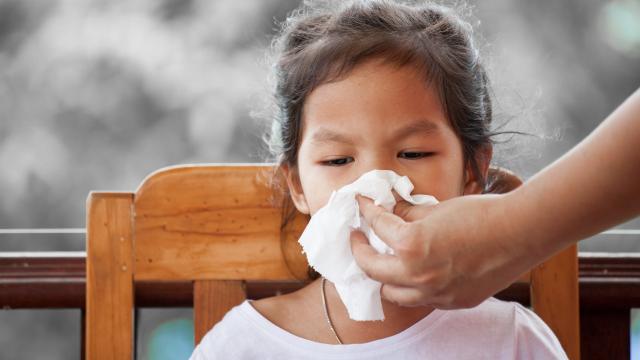Photo via Shutterstock
While going over the illness section of the handbook at my daughter’s preschool orientation, the director told parents, “If we made every kid with a runny nose stay home, we’d have no children here.” Kids get sick a lot and not every sniffle requires you to take a day off from work to nurse them back to health. But it can be tough to gauge whether your kid is too sick to go to school, and it often comes down to a judgment call.
Many parents don’t want other students to catch whatever it is their kid has, which is always one of my biggest concerns, but science tells us that most disease is actually spread before symptoms occur, so the current exclusion recommendations from the American Academy of Pediatrics have the main goal of making sure your child feels well enough to participate and allowing for class to run as usual. Your school and pediatrician may have specific guidelines for when to keep your kid home, but here’s what the AAP says:
Send ’em
Assuming your child is behaving normally and can participate in the activities, it’s ok to send them to school if he or she has:
- A common cold or runny nose, regardless of colour or consistency of nasal discharge.
- A cough not associated with a fever, rapid or difficult breathing, wheezing or cyanosis (blueness of skin or mucous membranes).
- Pink eye (bacterial conjunctivitis) indicated by pink or red conjunctiva with white or yellow eye mucous drainage and matted eyelids after sleep. Schools used to send children home for pink eye, but exclusion is no longer required. The AAP suggests thinking about it like the common cold — it may be passed onto other children, but can resolve itself without treatment.
- Watery, yellow or white discharge or crusting eye discharge without fever, eye pain or eyelid redness.
- A fever without any other symptoms (for children older than four months), regardless of whether acetaminophen or ibuprofen was given. The AAP states: “A fever is an indication of the body’s response to something, but is neither a disease nor a serious problem by itself.” A fever is defined as a temperature above 101 degrees.
- A rash without fever and behavioural changes. (Exception: Call 911 for rapidly spreading bruising or small blood spots under the skin.)
- Lice, as long as the child has started treatment.
Keep ’em home
Keep your child home — and talk to your doctor — if he or she has:
- Any illness that prevents the child from participating comfortably in school activities.
- A fever above 101 degrees with a behaviour change in infants older than 2 months. If your child is younger than 2 months, call your doctor any time he or she has a fever above 100.4 degrees.
- Diarrhoea not associated with changes in diet.
- Vomiting more than two times in the past 24 hours.
- Abdominal pain that continues for more than two hours.
- Mouth sores with drooling that the child cannot control.
- A rash with fever or behavioural changes.
- Strep throat, until the child has two doses of antibiotic.
- Head lice, only if the child has not been treated after notifying the family at the end of the prior program day. (note: exclusion is not necessary before the end of the program day)
- Chickenpox (varicella), until all lesions have dried or crusted.

Comments